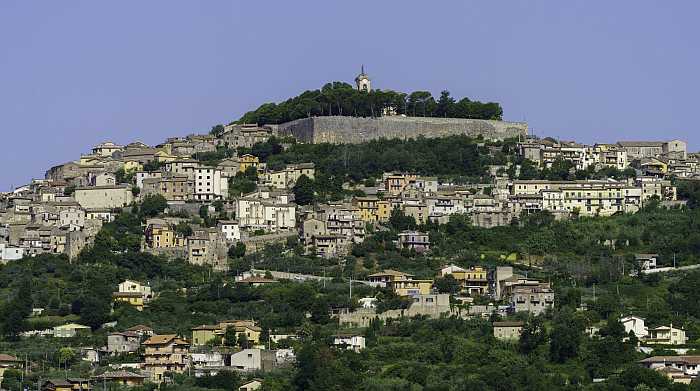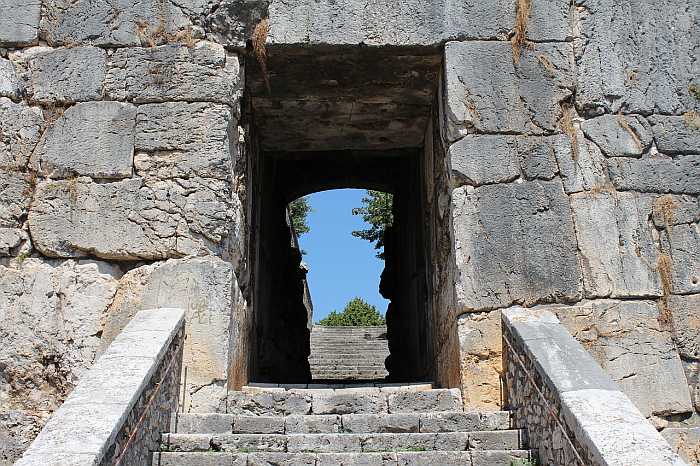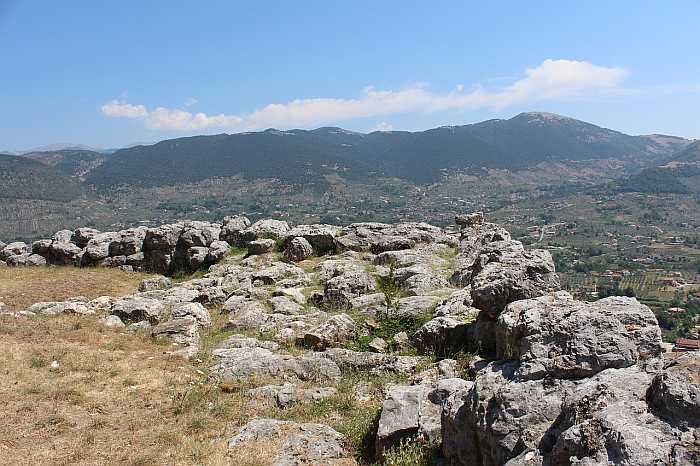
The historic town of Alatri (Photo: Envato)
When one thinks of the Lazio region, the first image that often comes to mind is Rome, "the Eternal City," with its vast wealth of historical, cultural, and artistic riches. However, this captivating Italian region boasts numerous lesser-known treasures, particularly amongst international visitors. These hidden gems offer unique experiences off the beaten path, immersing you in a different side of Italy's beauty.
Let's venture beyond the hustle and bustle, into the idyllic countryside of Ciociaria, about 1.5 - 2 hours by car from Rome. This region, one of the most emblematic within Lazio (*), is home to two of its most charming villages: Anagni and Alatri.
These villages are part of a network known as the "Cyclops Cities” (**), a term steeped in ancient Hellenic culture and mythology. Local legends attribute their founding to the Pelasgians, a mythical group hailing from Greece and Minor Asia. These legends suggest that the Pelasgians descended from the Greek god Chronos(***), later incorporated into the Roman pantheon as Saturn. Following his expulsion from Olympus, Saturn is said to have made his home in Lazio, leaving his mark on this enchanting region.

The Belvedere in Anagni (Photo: Pixabay)
A Journey Through Time in the Heart of the Cyclopean Walls
Alatri is famous for its massive, enigmatic walls known as the Cyclopean Walls. They are ancient megalithic fortifications built with giant, roughly cut boulders fitted together without mortar. These walls, that circle the acropolis of the city, are one of the best preserved examples of such ancient fortifications in Italy. They are named "Cyclopean" due to the belief in the Renaissance that only the mythical Cyclops could have moved such massive stones. Alatri's historic center also features narrow streets and medieval buildings that transport you back in time.
Anagni, also surrounded by Cyclopean walls, was an important center during the Roman times and later became the residence of the Popes during the Middle Ages. The city is sometimes called the "City of Popes", because four popes were born there. Anagni is also renowned for its splendid Romanesque cathedral and the Palazzo Papale. The medieval architecture of the city offers a glimpse of the powerful past of this town.
Indeed, due to their proximity to Rome, both Alatri and Anagni were early conquests during the expansion of the Roman Empire. This resulted in an interesting blend of cultures, where the original inhabitants' practices mixed with those of the Romans, creating a unique local culture that still influences the area today.
Walking the narrow streets of these towns, visiting their medieval buildings, and tracing the outlines of their ancient walls is a fascinating journey through time. These towns offer a rich, tangible experience of Italy's layered history, from pre-Roman to Roman times, and through the Middle Ages up to the present day.

Ancient gate in Alatri (Photo: Pixabay)
Artistic Masterpieces and Historical Landmarks
Both Alatri and Anagni are home to churches and cathedrals adorned with exceptional works of art. These religious sites boast the artistic grandeur of masters such as Cimabue and Giotto, who painted stunning frescoes that still capture the admiration of today's visitors.
Anagni, in particular, features the Barnekow house, an architectural marvel that has captivated the imagination of numerous travelers. Especially during the era of the "Grand Tours" in the 18th and 19th centuries, this spot was a must-visit destination for European intellectuals, artists, and aristocrats. The house is historically significant as it once hosted Dante Alighieri, the 14th-century author of the "Divine Comedy." This literary masterpiece, comparable to the best of Shakespeare's works, is known for its critical examination of the Church and several popes of the era, including Pope Boniface IX.
Both towns are adorned with picturesque piazzas and panoramic viewpoints that offer breath-taking views of the surrounding Ciociaria landscapes. Anagni's Piazza Cavour and Alatri's high point, the Civita, offer unique vistas that make you feel as though time has stood still in these ancient towns.
Beyond its scenic beauty, Alatri is also renowned for its Etruscan necropolis. This open-air museum takes you on a literal journey back in time, allowing you to explore a historical period dating back over 3,000 years. A visit to Alatri is like stepping into a different era, providing a unique opportunity to walk among the monuments of an ancient civilization.


Acropolis of Alatri (Photo: Pixabay)
Echoes of a Jewish Past: The Jewish Heritage in Alatri and Anagni
The presence of Jews in Rome represents the oldest Jewish diaspora in the Western world. Given this rich history, it's not surprising that Jewish settlements were also established in nearby towns like Alatri and Anagni. During the Medieval period, these towns fell under the temporal power of the Church. Today, no concrete traces of this Jewish presence remain. However, as you wander through the towns' streets and squares, you will be walking by the areas of the old ghetto with its synagogues and the cemeteries outside their walls.
An interesting historical note is that after these towns came under Church rule in the late 14th century, the Jewish community was granted the same rights as the Christian population by none other than Pope Bonifacio IX, one of the most hated popes even by the Christians. It is worthwhile to visit the Palazzo Gottifredo in Anagni and its museum where you will find a wide range of artifacts that cover the extensive timeline of local history. This includes the old Statutes (Statuti) issued by the Church. These statutes set the regulations for the local Jewish community and defined the relationship between the Christian and Jewish populations, providing a unique insight into the region's rich and diverse past.
Similar to many other places in Italy, there's a deep connection between local towns and their Jewish inhabitants, which can be traced through family names. The Jewish surnames "Alatri", "Alatrino", and "Alatrini" clearly indicate the families origins, reflecting the town of Alatri. They serve as a form of identification in case of expulsion from one town/area to a new one.
(*) LA CIOCIARA (that loosely translates as “The woman from Ciociaria”): great Italian movie from 1960, directed by Vittorio De Sica starring one of the best actresses, Sophia Loren – definitely worth watching. The film takes place in Rome and the surrounding countryside of the Ciociaria region during World War II. It tells the story of a mother's unwavering determination and struggle to protect her daughter amidst the harsh realities of World War II in Italy.
(**) CYCLOPS: mythological giants, most famous of which are those one eyed narrated by Homer in his poem “Odyssey”.
(***) CHRONOS: some modern words deriving from the name of this ancient Greek god are: chronology, chronometer (stopwatch), chronograph (a watch that also includes the function of a stopwatch) and synchronous. Basically any word related to time. In fact Chronos was the god of time.
Andrea Alcalay from La Tour I-Talya. LaTour I-Talya is a project established and managed by a team of Italian Jews working together with one of the largest and most prestigious Italian Tour Operators. LaTour I-Talya specializes in tour packages which focus on the amazingly rich Jewish historical and cultural heritage found throughout Italy.
Read more articles from our Hidden Gems of Italy series:
Echoes of the Past: Unraveling Trieste's Jewish Legacy
Exploring the Charm of Casale Monferrato
Get in Touch with the oldest Jewish community in Tuscany
The Jewish beauty of Florence
Mantua: First stop in the Renaissance cities of Northern Italy
Pitigliano: "Little Jerusalem" in the Tuscan Maremma Region
Cividale del Friuli: Jewish Tours of Italy off the Beaten Path
The Charming Padova (Padua)
The Marche Region: Undiscovered area of Central Italy
Andrea Alcalay from La Tour I-Talya. LaTour I-Talya is a project established and managed by a team of Italian Jews working together with one of the largest and most prestigious Italian Tour Operators. LaTour I-Talya specializes in tour packages which focus on the amazingly rich Jewish historical and cultural heritage found throughout Italy.
Read more articles from our Hidden Gems of Italy series:
Echoes of the Past: Unraveling Trieste's Jewish Legacy
Exploring the Charm of Casale Monferrato
Get in Touch with the oldest Jewish community in Tuscany
The Jewish beauty of Florence
Mantua: First stop in the Renaissance cities of Northern Italy
Pitigliano: "Little Jerusalem" in the Tuscan Maremma Region
Cividale del Friuli: Jewish Tours of Italy off the Beaten Path
The Charming Padova (Padua)
The Marche Region: Undiscovered area of Central Italy